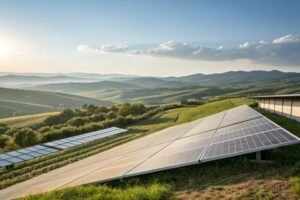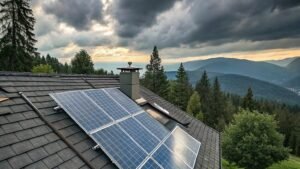Power Degradation in Solar Panels and Warranty Insights
•
Are your solar panels losing power faster than expected? Understanding degradation rates and warranty protections can save you thousands in long-term energy production.
Solar panels typically degrade at 0.5-0.8% annually, with most manufacturers guaranteeing at least 80% output after 25 years through tiered warranty structures.
While all solar panels lose efficiency over time, the rate and pattern of degradation significantly impacts your system's lifetime value - making warranty terms as important as the initial price.
What Is the Natural Degradation Rate of Solar Panels?
Why do solar panels produce less electricity each year? The answer lies in unavoidable material aging, though quality manufacturing can dramatically slow the process.
Premium solar panels degrade just 0.3-0.5% annually, while economy models may lose 1% or more, resulting in 15-25% performance differences over 25 years.
Understanding Degradation Factors
-
Material Science Behind Degradation
- UV exposure breaks down encapsulants
- Thermal cycling causes microcracks
- Potential-induced degradation (PID) in poor-quality cells
-
Performance Comparison by Panel Type Panel Type Year 1 Loss Annual Rate 25-Year Output Monocrystalline 2% 0.3% 92% Polycrystalline 3% 0.7% 80% Thin Film 5% 1% 70% -
Real-World Variables
- Hot climates accelerate degradation
- Proper installation reduces stress
- Regular maintenance prevents compounding issues
Pro Tip: Ask manufacturers for independent degradation test results (IEC 61215 standards) rather than relying on theoretical claims.
How Is the 25-Year Warranty Structured?
What exactly does a 25-year solar warranty cover? Most buyers are surprised to learn these contracts have carefully calculated performance guarantees.
Solar warranties typically guarantee 90% output at 10 years and 80% at 25 years, with linear degradation between these checkpoints - but exclusions often void coverage.
Decoding Warranty Fine Print
-
Tiered Performance Guarantees
- Year 1: 97-98% of rated power
- Year 10: ≥90%
- Year 25: ≥80%
-
Common Warranty Exclusions
- Physical damage from weather/human error
- Improper installation
- Systems not meeting minimum production thresholds
-
Claim Process Reality Step Typical Timeline Cost Considerations Testing 2-4 weeks $300-800 inspection fee Approval 4-8 weeks Often prorated compensation Replacement 8-12 weeks Labor rarely covered
Key Insight: Many "25-year warranties" actually consist of separate 10-year product warranties and 25-year performance guarantees with different terms.
How to Minimize Long-Term Loss from Degradation
Can you actually slow solar panel degradation? Strategic choices before installation and simple maintenance practices can preserve your system's output for decades.
Optimizing tilt angles, ensuring proper ventilation, and annual cleaning can reduce degradation by 30-50%, while microinverters minimize whole-system impacts from individual panel declines.
Proactive Degradation Management
-
Installation Best Practices
- 3-6 inch rear ventilation space
- 30-35 degree tilt in most climates
- PID-resistant racking systems
-
Maintenance Schedule Task Frequency Impact Visual inspection Biannual Early crack detection Thermal scan Every 3 years Hot spot prevention Professional cleaning Annual 3-5% output boost -
Technology Solutions
- Optimizers for partial shading
- DC-coupled storage to capture excess
- Monitoring software for trend analysis
"Systems with proper airflow degrade 0.2% slower annually - that's 5% more power over 25 years" - National Renewable Energy Laboratory
Conclusion
Smart solar buyers consider degradation rates and warranty details as carefully as upfront costs - because preserving just 1% more annual output can mean thousands in additional lifetime value.






